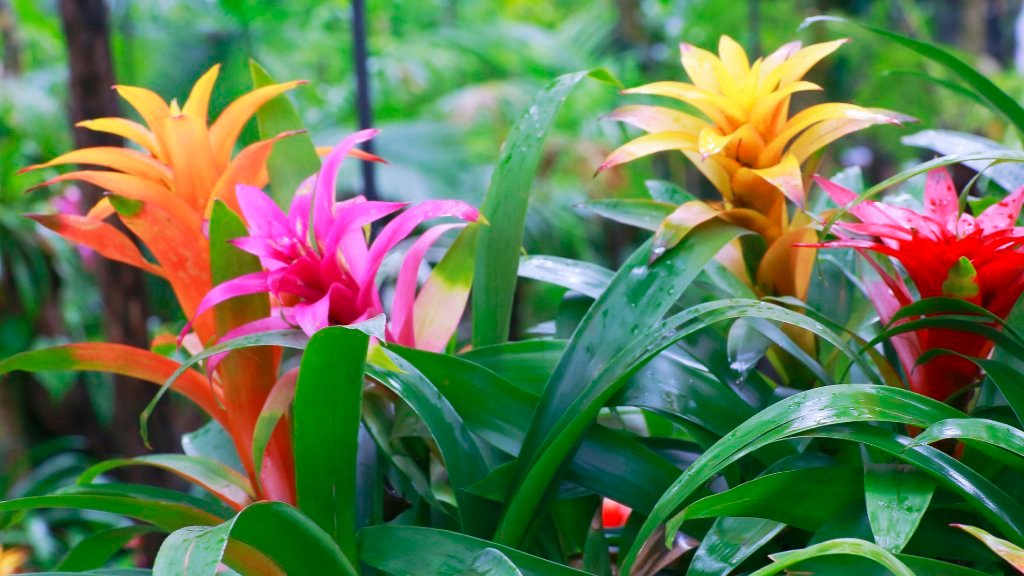Bromeliads are a popular choice for indoor plant enthusiasts due to their striking appearance and relatively low-maintenance care requirements. Native to tropical and subtropical regions, these plants bring a splash of exotic color to homes and gardens with their bright blooms and unique foliage. Whether you’re a seasoned plant parent or new to the world of indoor plants, learning how to care for a bromeliad in 2024 will ensure your plant thrives year-round. Let’s explore the best practices to keep your bromeliad healthy and vibrant.
1. Choosing the Right Spot
Bromeliads thrive in bright, indirect light. They can tolerate lower light levels but will bloom better when given sufficient sunlight. When positioning your bromeliad indoors, place it near a window where it can receive filtered light, but avoid direct sunlight, which can scorch its leaves.
Ideal Light Conditions:
- Bright, indirect light: East or north-facing windows work well.
- Avoid direct sunlight: Too much sun can cause leaf burn.
2. Watering Your Bromeliad
Bromeliads are relatively drought-tolerant, but they have specific watering needs. These plants absorb most of their moisture through their central cup (also called a “tank”), which forms naturally in the center of the leaves. Keep this cup filled with water and replace the water every week to prevent stagnation and bacteria buildup.
Watering Tips:
- Fill the plant’s central cup with filtered water or rainwater to avoid mineral buildup.
- Water the soil lightly, but ensure the pot has good drainage to avoid root rot.
- Humidity is essential—place a humidifier nearby or mist the plant frequently if you live in a dry climate.
3. Soil and Potting Requirements
Bromeliads need well-draining soil to prevent waterlogging. Unlike many other houseplants, bromeliads do not require rich, heavy soil. A light, fast-draining potting mix, such as orchid bark or a succulent mix, works well. Bromeliads are epiphytes (air plants) in nature, meaning they don’t rely heavily on soil nutrients.
Soil Tips:
- Use a light, aerated mix with materials like peat moss, perlite, or orchid bark.
- Ensure the pot has adequate drainage holes to prevent water buildup.
4. Temperature and Humidity Needs
Bromeliads are tropical plants, so they thrive in warm, humid environments. They prefer temperatures between 60°F and 80°F (15°C to 27°C). If the temperature drops below this range, bromeliads can become dormant and struggle to thrive.
Temperature and Humidity Tips:
- Keep your bromeliad away from cold drafts and air conditioning vents.
- Maintain a high humidity level—at least 50%—to mimic their natural environment.
- For added humidity, use a pebble tray or place your bromeliad in a bathroom or kitchen, where humidity levels are naturally higher.
5. Fertilizing Your Bromeliad
Bromeliads are light feeders, so they don’t require heavy fertilization. A balanced, water-soluble fertilizer diluted to half strength every two to three months during the growing season is enough to keep your plant healthy. Avoid over-fertilizing, as it can cause the plant to lose its vibrant color or damage its central cup.
Fertilizing Tips:
- Use a balanced, diluted fertilizer during the spring and summer months.
- Fertilize the soil lightly, avoiding direct application to the plant’s central cup.
- Skip fertilizer during the winter months when the plant is dormant.
6. Encouraging Blooms
One of the most attractive features of a bromeliad is its vibrant bloom. While bromeliads typically bloom only once in their lifetime, the flower can last for several months. After flowering, the plant will produce pups or small offsets, which can be propagated to grow new bromeliad plants.
Blooming Tips:
- To encourage blooming, keep the plant in bright, indirect light.
- Create a slightly more humid environment during the flowering period.
- You can place the plant in a sealed bag with an apple for a week or two—the ethylene gas released by the apple can stimulate the bloom.
7. Repotting and Propagating Bromeliads
Bromeliads don’t need frequent repotting and typically don’t outgrow their pots. However, after the plant blooms, it will begin producing offsets, or pups, which can be repotted to create new plants. Once the pups are one-third the size of the mother plant, they can be separated and planted on their own.
Propagation Tips:
- Gently twist or cut the pup away from the mother plant with a sterile knife.
- Plant the pup in a well-draining potting mix and water lightly.
Conclusion
Caring for a bromeliad plant in 2024 is easier than it seems, as long as you provide the right balance of light, water, and humidity. These tropical beauties can brighten up any space with their colorful blooms and unique foliage. By following these care tips, you’ll enjoy a healthy bromeliad that thrives for years to come, even after its stunning bloom fades.

